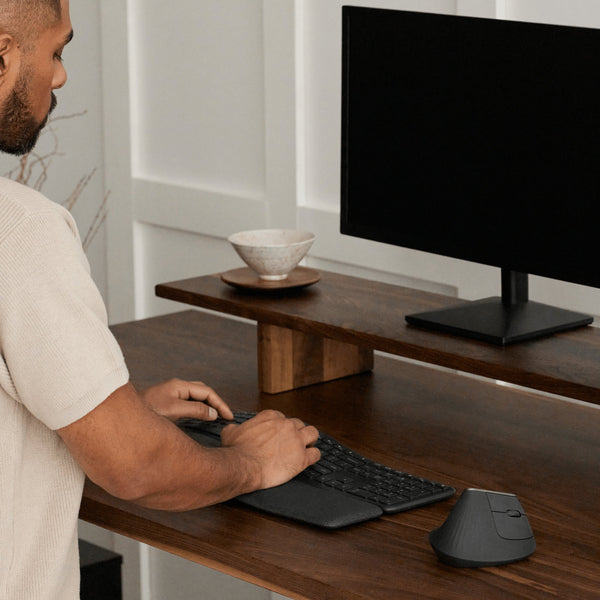From improved posture, energy, focus, well-being, and even productivity, the benefits of using standing desks are vast and well-known. Yet not enough people know how to get the most from their good investment when they first start using them. It’s important to read more than just the user manual! When going from occupational sitting to occupational standing, it’s vital to learn how to transition properly, or else you might develop unnecessary body pains.
Quick overview of office sit-stand goals
Ultimate goal: Move more, sit less
Minimum suggested standing time: 5-20 minutes per hour
Reasonable standing time: 50% of your workday (~ 4hrs)
Maximum suggested standing time: 80% of your workday (~ 6 hrs)
Ideal standing session: 45 minutes at a time
Ideal sitting session: 30 minutes at a time
Movement frequency: Alternate position, stretch, and/or walk every 30 to 45 minutes
1- Don’t stand for longer than you should
What’s the ideal ratio of standing versus sitting? This is probably the most frequently asked question for first time users of standing desks. A recent study from the University of Waterloo says the ideal ratio for standing-to-sitting time is between 1:1 and 3:1. This means you should aim to stand one hour for every hour you spend sitting as a minimum, and ideally you should stand for up to 3 hours for every 1 hour you spend sitting. To break it down in the context of typical office hours, this means that in an 8-hour workday you should aim to stand between 4 to 6 hours.
These daily totals should be broken up into smaller sessions, so that you may frequently alternate between standing and sitting. To prevent body pains, make sure to spend no longer than 1.5 hours at a time standing, and no longer than 30 minutes at a time sitting. And when it's time to sitting position, choosing a comfortable desk chair or a tilt ergonomic stool can make all the difference.
A recent study from the University of Waterloo says the golden ratio for standing-to-sitting time is between 1:1 and 3:1.
Revitalize your work routine with some easy exercises
2- Start slow: your body needs to adjust
If you've been sitting at a desk for 10 years, you'll want to start gradually and work your way up to an ideal number of standing hours. If you're right out of college and beginning your first desk job, you might find your adjustment period shorter than average. Either way, neither of you would attempt a 300lb deadlift at the gym on your first day! So, don’t be unrealistic with your body’s threshold for standing endurance from day one.Make it your goal to stand for only 1 hour per day at first, broken up in small sessions of 15 to 20 minutes. It may not seem like much, but the last thing you want to do is overexert your normally sedentary body, and give up before you’re ahead. You can gradually increase the amount of standing time by 5-10 minutes per week. As you get used to standing for longer periods of time, you can slowly work your way up to the ideal range.
3- Use a proper posture while standing
Besides the obvious (standing up straight) there are additional adjustments you can make to prevent muscle pain while standing. Making sure to keep your neck neutral, your wrists straight, your shoulders back, and your elbows at 90 degrees are all part of the ergonomic equation. Take a look at our article How to use my sit-stand desk correctly for step-by-step instructions on adjusting every aspect of your active workstation. It will give you additional tips like keeping your knees bent to reduce pressure on your hips, and keeping a small footrest under your desk so you can switch your body weight from one foot to the other, easing any strain on your back and feet.
4- Choose your own adventure
There’s no general consensus on which tasks are more suited to one posture vs. another. Some people feel more alert and focused while standing, so they like to do tasks that require concentration like writing; while others prefer to do tasks that require less focus like reading. Most people prefer to sit for skills requiring fine motor skills or precision, and to stand when they're making an important sales pitch over the phone, since the added energy in your voice makes the conversation livelier.
Whether you choose to spend your standing time responding to emails, taking calls, reading reports, or writing the next Great American Novel like Hemingway did with his standing desk, the freedom of choice and movement makes using height adjustable desks a highly personalized experience. Remember to save your preferred height settings according to your body’s proportions so you can easily switch from sitting to standing and vice versa.
5- Focus on moving more than standing
Basically, to take full advantage of the multiple benefits of standing desks, it's important to consider making a gradual transition, alternating between sitting and standing positions. Even though the ideal ratio may vary according to various factors, keep in mind that a proportion of sitting to standing of around 1:1 to 3:1 is considered to be optimal. Find your own formula and elevate your work experience!






Leave a comment